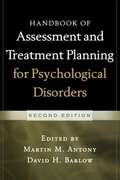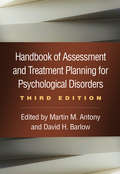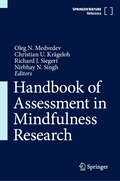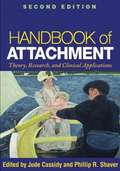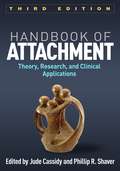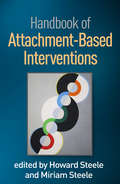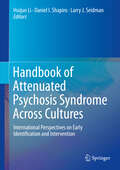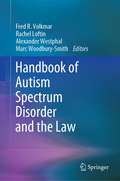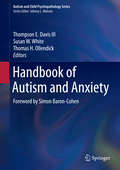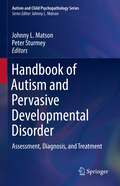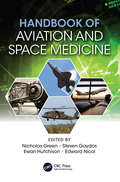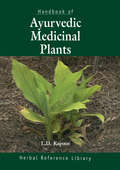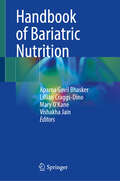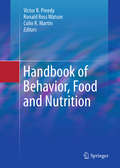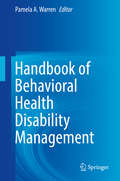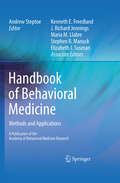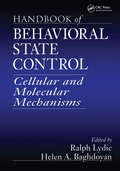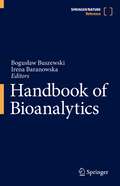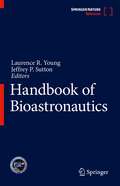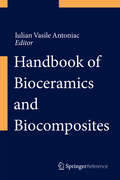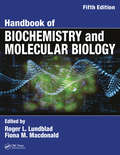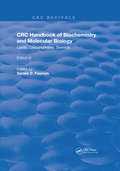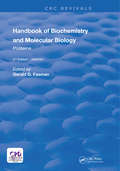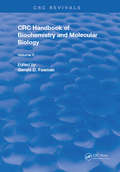- Table View
- List View
Handbook of Assessment and Treatment Planning for Psychological Disorders, 2/e
by David Barlow Martin AntonyWidely regarded as a premier clinical reference, this book provides state-of-the-science tools for conducting effective assessments and using the results to plan and monitor evidence-based interventions. Leading authorities present proven approaches to screening and assessment for specific psychological problems. They offer practical guidance and case examples to help clinicians select the best measures for different populations and assessment purposes. Recommended instruments and procedures are described, including applications for managed care and primary care settings. Many of the chapters feature detailed tables that compare and contrast relevant measures. New to This Edition Thoroughly updated with new instruments and research findings. Chapter on the role of assessment in evidence-based treatment. Additional disorder-specific chapter impulse control disorders. Chapter explaining how to evaluate the reliability and validity of a measure.
Handbook of Assessment and Treatment Planning for Psychological Disorders, Third Edition
by David H. Barlow Martin M. AntonyThis authoritative clinical reference and text--now revised and updated with 50% new content--presents the assessment tools and strategies that every evidence-based psychotherapy practitioner needs. Unlike most assessment texts, the volume is organized around specific clinical problems. It explains how to select and use the best measures to assess clients' symptoms, generate diagnoses, plan appropriate treatments, and monitor progress. Clinician- and student-friendly features include tables comparing and contrasting relevant measures, sample forms, and case examples. Every chapter addresses considerations for primary and managed care settings. New to This Edition *Chapters on new topics: assessment of well-being and transdiagnostic assessment. *New chapters on core topics: eating disorders, personality disorders, and insomnia. *Updated throughout with DSM-5 diagnostic changes, new and updated instruments, current research, and increased attention to transdiagnostic concerns. *Expanded coverage of obsessive–compulsive and related disorders. See also Clinical Handbook of Psychological Disorders, Fifth Edition, edited by David H. Barlow, which presents evidence-based treatments step by step.
Handbook of Assessment in Mindfulness Research
by Nirbhay N. Singh Richard J. Siegert Christian U. Krägeloh Oleg N. MedvedevThis handbook provides comprehensive coverage of assessment instruments used in mindfulness research. It discusses traditional and modern approaches used to develop psychometric measures and to establish their reliability and validity, such as classical test theory, item response theory and Rasch model, generalizability theory, facet benchmarking, and network analysis. The handbook provides information on conceptual foundations, development, and psychometric properties of assessment instruments used to measure mindfulness in children, adolescents, and adults. In addition, it provides similar information on scales used in specific contexts and for various purposes. It reviews behavioral, cognitive, and psychophysiological assessment measures of mindfulness. The handbook examines a broad range of psychological, physical health, and mental health, and related measures that are used in mindfulness research. This reference work enables researchers to choose appropriate measurement tools fora broad range of mindfulness research.Key areas of coverage include:Nature and theoretical foundations of assessment.Origins and definitions of mindfulness.Mindfulness scales for children and adolescents.Mindfulness scales for adults.Mindfulness scales for specific contexts and purposes.Mindfulness and Buddhist-related scales.Behavioral assessments of mindfulness.Cognitive and psychophysiological assessments of mindfulness. The Handbook of Assessment in Mindfulness Research is an essential reference for researchers, professors, and graduate students as well as clinicians, therapists, and other mental health practitioners in clinical psychology and affiliated medical and mental health disciplines, including complementary and alternative medicine, social work, occupational and rehabilitation therapy.
Handbook of Attachment, Second Edition
by Jude Cassidy Phillip ShaverFrom foremost authorities, this comprehensive work is more than just the standard reference on attachment-it has "become indispensable" in the field. Coverage includes the origins and development of attachment theory; biological and evolutionary perspectives; and the role of attachment processes in personality, relationships, and mental health across the lifespan. New to This Edition A decade's worth of major theoretical and empirical advances. Chapters on foster care, attachment in middle childhood, affect regulation, divorce, the neuroscience of attachment, and attachment in later life. Findings on disorganized attachment and psychopathology.
Handbook of Attachment, Third Edition: Theory, Research, and Clinical Applications
by Jude Cassidy Phillip R. ShaverWidely regarded as the state-of-the-science reference on attachment, this handbook interweaves theory and cutting-edge research with clinical applications. Leading researchers examine the origins and development of attachment theory; present biological and evolutionary perspectives; and explore the role of attachment processes in relationships, including both parent-child and adult romantic bonds. Implications for mental health and psychotherapy are addressed, with reviews of exemplary attachment-oriented interventions for children and adolescents, adults, couples, and families. Contributors discuss best practices in assessment and critically evaluate available instruments and protocols. New to This Edition *Chapters on genetics and epigenetics, psychoneuroimmunology, and sexual mating. *Chapters on compassion, school readiness, and the caregiving system across the lifespan. *Chapter probing the relation between attachment and other developmental influences. *Nearly a decade's worth of theoretical and empirical advances.
Handbook of Attachment-Based Interventions
by Howard Steele Miriam SteeleThe first volume to showcase science-based interventions that have been demonstrated effective in promoting attachment security, this is a vital reference and clinical guide for practitioners. With a major focus on strengthening caregiving relationships in early childhood, the Handbook also encompasses interventions for school-age children; at-risk adolescents; and couples, with an emphasis on father involvement in parenting. A consistent theme is working with children and parents who have been exposed to trauma and other adverse circumstances. Leading authorities describe how their respective approaches are informed by attachment theory and research, how sessions are structured and conducted, special techniques used (such as video feedback), the empirical evidence base for the approach, and training requirements. Many chapters include illustrative case material.
Handbook of Attenuated Psychosis Syndrome Across Cultures: International Perspectives on Early Identification and Intervention
by Huijun Li Larry J. Seidman Daniel I. ShapiroThis handbook examines state-of-the-art research and clinical findings on attenuated psychosis syndrome (APS) across the globe. It addresses symptoms, assessment methods, and treatment approaches as they differ and converge across countries and cultures. The handbook explores how the illness impairs many aspects of daily functioning, with high rates of suicide and a reduced life span. It details how early detection is critical and may greatly reduce the public health burden of the illness. Chapters describe the early identification and intervention efforts that are currently underway across the world. The book offers international findings from prominent researchers, elaborating culturally relevant illness symptoms, help-seeking behaviors, and assessment and intervention strategies. In addition, chapters illustrate wide variations in symptom expression and experience, reinforcing the necessity of culturally attuned practice in patient-centered care. The book concludes by examining the implications – challenges and opportunities – for future research and clinical practices from an international perspective.Topics featured in the Handbook include:Barriers to service in low-resourced countries. The role of traditional or culturally acceptable care in developing early intervention models. The reliability and validity of tools for assessing and identifying APS.Possible medical diagnoses that can present with APS symptoms and how to differentiate these conditions from APS. The Handbook of Attenuated Psychosis Syndrome Across Cultures is a must-have resource for researchers, professors, clinicians, and related professionals as well as graduate students in child and school psychology, psychiatry, social work, and related disciplines.
Handbook of Atypical Parkinsonism
by Carlo Colosimo David E. Riley Gregor K. WenningImproved diagnostic sophistication is increasingly enabling neurologists to differentiate between Parkinson's disease and other atypical parkinsonism (AP), such as multiple system atrophy, progressive supranuclear palsy, corticobasal degeneration, and dementia with Lewy bodies. The Handbook of Atypical Parkinsonism is a comprehensive survey of all diseases of this category, providing an authoritative guide to the recognition, diagnosis and management of these disorders. Each chapter follows a common structure, commencing with the full basic science of the disorder under consideration, followed by descriptions of the clinical picture and differential diagnosis. Subsequent chapters discuss current and future therapeutic approaches to these difficult conditions. Written and edited by leading practitioners in the field, clinicians in neurology and other specialties will find this book essential to the understanding and diagnosis of this complex group of disorders.
Handbook of Autism Spectrum Disorder and the Law
by Fred R. Volkmar Rachel Loftin Alexander Westphal Marc Woodbury-SmithThis book addresses an important and relatively neglected topic in the scientific literature: individuals with autism spectrum disorder (ASD) who have dealings with the legal system. It examines issues and implications for autistic people, who have a significant risk for engagement with the legal system in some capacity (e.g., witness/bystander, victim, or perpetrator).Key areas of coverage include:Autistic people as victims and perpetrators of criminal activities, including violence, stalking, sexual exploitation, and cybercrime. Risks for unlawful behavior in individuals with autism and Asperger's. Legal assessment issues, such as witness protection and postconviction diagnoses. Legal outcomes for autistic people, including case law, prevention, service provisions in correctional settings, and rights and support systems. The Handbook of Autism Spectrum Disorder and the Law is an essential, comprehensive resource that explores the risk for unlawful behaviors affecting autistitc people as victims and perpetrators, as well as related issues of assessment and treatment, and outcome. It is a must-have reference for researchers, clinicians/practitioners, and graduate students in psychology, psychiatry, social work, and law, as well as professionals in such related fields, as criminology/criminal justice and the legal system.
Handbook of Autism and Anxiety
by Thomas H. Ollendick Thompson E. Davis III Susan W. WhiteThe diagnosis of autism spectrum disorder (ASD) has evolved greatly since Asperger's day. And as our clinical understanding of this spectrum of disorders has grown, so has recognition of the connections between anxiety disorders and ASD--a welcome development, but also a source of confusion for many in the field. The Handbook of Autism and Anxiety brings together leading experts to explain this comorbidity, the diagnostic similarities and differences between the two disorders and the extent to which treatment for each can be coordinated for optimum results. Focusing on repetitive behaviors, social difficulties and fears as core components of anxiety disorders as well as ASD, contributors discuss specific symptoms in depth to aid in diagnosis. Assessment and treatment issues relevant to the autism-anxiety connection are considered in clinical and school contexts. And an especially timely conclusion details how key changes in the DSM-5 affect the diagnosis and conceptualization of each disorder. Key topics addressed in the Handbook include: Phenotypic variability in ASD: clinical considerations. Etiologic factors and transdiagnostic processes. Social worries and difficulties: autism and/or social anxiety disorder? Implementing group CBT interventions for youth with ASD and anxiety in clinical practice. Autism and anxiety in school settings. DSM-5 and autism spectrum disorder. The Handbook of Autism and Anxiety is an essential resource for researchers, clinicians/professionals and graduate students in child and school psychology, psychiatry, social work, education, clinical counseling and behavioral therapy.
Handbook of Autism and Pervasive Developmental Disorder: Assessment, Diagnosis, and Treatment (Autism and Child Psychopathology Series)
by Johnny L. Matson Peter SturmeyThis handbook provides a substantive foundation of autism theory and research, including a comprehensive overview, conceptualization, and history of autism spectrum disorder (ASD) and pervasive developmental disorder (PDD). This robust reference work integrates the broad scholarly base of literature coupled with a trenchant analysis of the state of the field in nosology, etiology, assessment, and treatment. Its expert contributors examine findings and controversies (e.g., the actual prevalence of autism) as well as longstanding topics of interest as well as emerging issues from around the globe. In addition, the handbook describes multiple assessments, diagnoses, interventions and treatments for autism and PDD. It addresses such key topics as assessment of core symptoms and comorbidities, risk factors, epidemiology, diagnostic systems, neuroscience as well as issues regarding family adaptation. In addition, the handbook explores the rapidly evolving and expanding topics of medications, diets, fringe and harmful treatments, applied behavior analysis, and early intensive behavioral interventions.Key areas of coverage include:Survey of diagnostic criteria and assessment strategies for autism and pervasive developmental disorder.Genetic, behavioral, biopsychosocial, and cognitive models of autism assessment and treatment.Psychiatric disorders in individuals with ASD.Theory of mind and facial recognition in persons with autism.Diagnostic instruments for assessing core features and challenging behaviors in autism and PDD.Evidence-based psychosocial, pharmacological, and integrative treatments for autism and other developmental disabilities.Interventions specifically for adults with ASD.Training issues for professionals, parents, and other caregivers of individuals with autism and developmental disabilities.Review of findings of successful and promising therapies coupled with guidance on how to distinguish between dubious and effective treatments for autism and PDD. The handbook is an indispensable resource for researchers, professors, graduate students as well as clinicians, therapists, and other practitioners in clinical child and school psychology, child and adolescent psychiatry, social work, special education, behavioral rehabilitation, pediatric medicine, developmental psychology, and all allied disciplines.
Handbook of Aviation and Space Medicine: First Edition
by Nicholas Green Steven J. Gaydos Ewan J. Hutchison Ed NicolThis highly practical guide is ideal for any medical professional who deals with the aerospace environment or is involved in the healthcare of aircrew or individuals preparing for or returning from aerospace travel. The book covers all the main aspects of aerospace medicine, including the salient physiology and clinical aspects in note form for rapid assimilation, and makes plentiful use of figures, algorithms and tables throughout. <p><p> The book will be an indispensable companion to all civil and military aviation medicine practitioners including those preparing for professional qualifying examinations, and a useful aid for other physicians with an interest in aviation medicine or who are required to inform patients regularly regarding the likely effects of flight, including family practitioners and hospital doctors, physiologists with an interest in the area and occupational and public health personnel.
Handbook of Ayurvedic Medicinal Plants: Herbal Reference Library
by L.D. KapoorThis handbook is filled with over 50 illustrations and descriptions of approximately 250 plants which are used for herbal medicine. It includes information on medicinal plants ranging from Abies spectabilis to Zizyphus vulgaris. The purpose of this handbook is to make available a reference for easy, accurate identification of these herbs. Derived from India, ""Ayurveda"" is the foundation stone of their ancient medical science. Approximately 80 percent of the population of India and other countries in the East continue to utilize this system of medicinal treatment. It is believed that the key to successful medication is the use of the correct herb. This is an indispensable resource for all physicians, pharmacists, drug collectors, and those interested in the healing arts.
Handbook of Bariatric Nutrition
by Aparna Govil Bhasker Lillian Craggs-Dino Vishakha Jain Mary O'KaneThe book covers all aspects of nutrition and well-being for patients who undergo metabolic and bariatric surgery. It also covers basic aspects of patho-physiology of obesity. With rising rates of obesity, metabolic and bariatric surgery is on the rise across the world. As metabolic and bariatric surgery leads to a major change in diet and has a potential to lead to nutritional deficiencies, there is an increasing need for experts in bariatric nutrition. The book explains the approach protocols and applications in the pre-surgery and post- surgery period. It covers the prevention and management of nutritional deficiencies in detail and contains relevant case scenarios to enhance the understanding of the readers. It explains specific nutritional approach to patients with special considerations who undergo metabolic and bariatric surgery, such as liver and kidney disease, organ transplant, pregnancy, adolescence, etc. The book provides easy-to-follow algorithms for nutrient supplementation and key points in each chapter. The book provides consolidated information on bariatric nutrition. It serves as a useful resource for practicing dietitians / nutritionists and students alike, surgeons, physicians and any other practitioners involved in metabolic and bariatric surgery.
Handbook of Behavior, Food and Nutrition
by Victor R. Preedy Ronald Ross Watson Colin R. MartinThis book disseminates current information pertaining to the modulatory effects of foods and other food substances on behavior and neurological pathways and, importantly, vice versa. This ranges from the neuroendocrine control of eating to the effects of life-threatening disease on eating behavior. The importance of this contribution to the scientific literature lies in the fact that food and eating are an essential component of cultural heritage but the effects of perturbations in the food/cognitive axis can be profound. The complex interrelationship between neuropsychological processing, diet, and behavioral outcome is explored within the context of the most contemporary psychobiological research in the area. This comprehensive psychobiology- and pathology-themed text examines the broad spectrum of diet, behavioral, and neuropsychological interactions from normative function to occurrences of severe and enduring psychopathological processes.
Handbook of Behavioral Health Disability Management: Innovations In Prevention And Management
by Pamela A. WarrenThis authoritative handbook provides an up-to-date, interdisciplinary understanding of behavioral health issues and their management within disability systems. It examines today’s complex mismatches between providers, pinpointing related obstacles to relevant diagnosis, referrals, and care while making a solid case for better coordination and collaboration between primary care physicians and a wide range of disability and mental health specialists. Chapters review current findings on common job-related mental health and psychosocial issues, and guide readers through the tangle of insurance and legal concerns typically associated with disability cases. This elegant framework models more effective case management, leading to enhanced client satisfaction and functioning, and improved individual and system outcomes. Among the topics covered: A critique of the behavioral health disability system. Systemic-caused iatrogenic behavioral health disability and contradiction between diagnostic systems. Effective psychological evaluation and management of behavioral health concerns. Behavioral health disability and occupational medicine—concepts and practices. Physical therapy treatment and the impact of behavioral health concerns. A neuroplastic model of secondary contribution to behavioral health disability: theory and implications. With its practical solutions to large-scale health care problems, the Handbook of Behavioral Health Disability Management is necessary reading for health psychologists and professionals in rehabilitation, psychotherapy and counseling, occupational medicine, and allied fields as well as other stakeholders involved in the disability process.
Handbook of Behavioral Medicine
by Stephen B Manuck Andrew Steptoe Maria M. Llabre Kenneth Freedland J. Richard Jennings Elizabeth J. SusmanBehavioral medicine emerged in the 1970s as the interdisciplinary field concerned with the integration of behavioral, psychosocial, and biomedical science knowledge relevant to the understanding of health and illness, and the application of this knowledge to prevention, diagnosis, treatment, and rehabilitation. Recent years have witnessed an enormous diversification of behavioral medicine, with new sciences (such as genetics, life course epidemiology) and new technologies (such as neuroimaging) coming into play. This book brings together such new developments by providing an up-to-date compendium of methods and applications drawn from the broad range of behavioral medicine research and practice. The book is divided into 10 sections that address key fields in behavioral medicine. Each section begins with one or two methodological or conceptual chapters, followed by contributions that address substantive topics within that field. Major health problems such as cardiovascular disease, cancer, HIV/AIDs, and obesity are explored from multiple perspectives. The aim is to present behavioral medicine as an integrative discipline, involving diverse methodologies and paradigms that converge on health and well being.
Handbook of Behavioral State Control: Cellular and Molecular Mechanisms
by Ralph Lydic Helen A. BaghdoyanHandbook of Behavioral State Control: Cellular and Molecular Mechanisms provides the first synthesis of information on the neurobiology of behavioral states, ranging from normal stress and sleep deprivation to debilitating neuropsychiatric disorders. This book presents a working reference on the cellular and molecular mechanisms generating arousal
Handbook of Bioanalytics
by Irena Baranowska Bogusław BuszewskiThis book presents an authoritative review of analytical methods used for diagnostics, medical therapy and for forensic purposes. Divided into 4 parts, the book discusses new challenges in bioanalytics, covers bioanalysis as a source of clinical, pharmaceutical and forensic information, explores natural resources as a source of biologically active compounds, and offers new analytical strategies and equipment solutions. Written by interdisciplinary expert academics, this work will appeal to a wide readership of students, researchers and professionals interested in the fields of medicine, chemistry, pharmaceutical, life and health sciences, engineering and environmental protection. Clinicians and employees of forensic laboratories will also find this work instructive and informative.
Handbook of Bioastronautics
by Laurence R. Young Jeffrey P. SuttonThis comprehensive handbook serves the needs of biomedical researchers, space mission planners and engineers, aerospace medicine physicians, graduate students, and professors interested in obtaining an up-to-date and readable introduction to bioastronautics, the science of humans in space. Following the excitement and progress of the birth of the space age in the fifties and sixties, with the successes in human space flight – culminating with the Moon landings – the field of bioastronautics retreated into the more workmanlike arena of successively longer stays in low Earth orbit. At this time, major new initiatives are ahead both in human and robotic space exploration. The International Space Station, along with the developing Chinese space station and lunar program, will permit the development and testing of the means of astronaut protection for long duration missions – eventually to Mars and its moons, as well as visits to asteroids, other NEOs, and the Lagrange points. New life support systems and innovative approaches to radiation protection beyond Earth’s magnetic field will all be developed and tested. Meanwhile, the search for extraterrestrial life, past or even present, is accelerating – with the spectacular finds of Martian water and the discovery of potentially habitable extra-solar planets. A new generation of scientists is ready to attack a new set of problems, and is in need of an efficient, accurate and searchable means of discovering the essentials of the field. This reference work also covers the challenges, past achievements, and potential solutions inherent to the safe exploration of distant space and the search for life off our planet. The entries summarize the tertiary literature and include sufficient data and illustrations to introduce each topic, while avoiding the length and detail of scientific review articles.
Handbook of Bioceramics and Biocomposites
by Iulian Vasile AntoniacThis handbook describes several current trends in the development of bioceramics and biocomposites for clinical use in the repair, remodelling, and regeneration of bone tissue. Comprehensive coverage of these materials allows fundamental aspects of the science and engineering to be seen in close relation to the clinical performance of dental and orthopaedic implants. Bioceramics and biocomposites appear to be the most dynamic area of materials development for both tissue engineering and implantable medical devices. Almost all medical specialties will continue to benefit from these developments, but especially dentistry and orthopaedics. In this Handbook, leading researchers describe the use of bionanomaterials to create new functionalities when interfaced with biological molecules or structures. Also described are technologies for bioceramics and biocomposites processing in order to fabricate medical devices for clinical use. Another important section of the book is dedicated to tissue regeneration with development of new matrices. A targeted or personalized treatment device reduces drug consumption and treatment expenses, resulting in benefits to the patient and cost reductions for public health systems. This authoritative reference on the state-of-the-art in the development and use of bioceramics and biocomposites can also serve as the basis of instructional course lectures for audiences ranging from advanced undergraduate students to post-graduates in materials science and engineering and biomedical engineering.
Handbook of Biochemistry and Molecular Biology
by Fiona Macdonald Roger L. LundbladEdited by renowned protein scientist and bestselling author Roger L. Lundblad, with the assistance of Fiona M. Macdonald of CRC Press, this fifth edition of the Handbook of Biochemistry and Molecular Biology gathers a wealth of information not easily obtained, including information not found on the web. Presented in an organized, concise, and simple-to-use format, this popular reference allows quick access to the most frequently used data. Covering a wide range of topics, from classical biochemistry to proteomics and genomics, it also details the properties of commonly used biochemicals, laboratory solvents, and reagents. An entirely new section on Chemical Biology and Drug Design gathers data on amino acid antagonists, click chemistry, plus glossaries for computational drug design and medicinal chemistry. Each table is exhaustively referenced, giving the user a quick entry point into the primary literature. New tables for this edition: Chromatographic methods and solvents Protein spectroscopy Partial volumes of amino acids Matrix Metalloproteinases Gene Editing Click Chemistry
Handbook of Biochemistry and Molecular Biology: Lipids Carbohydrates, Steroids (Routledge Revivals)
by Gerald D. FasmanPublished in 1975: This volume contains the completed section of the Handbook of Biochemistry and Molecular Biology with data pertaining to Lipids, Carbohydrates, and Steroids.
Handbook of Biochemistry: Section A Proteins, Volume I (Routledge Revivals Ser.)
by Gerald D FasmanThis first volume contains data on amino acids which consists of the coefficients of solubility in water, heat capacities, entropies of formation, and heats of combustion. Specific gravity liquids, sucrose solution, CsCI solution isokinetic glycerol and sucrose gradients for density gradient centrifugation and the temperature dependence for select compounds are included.
Handbook of Biochemistry: Section A Proteins, Volume II (Routledge Revivals Ser.)
by Gerald D FasmanThe fields of biochemistry and molecular biology are two areas in which the information explosion is manifest.
